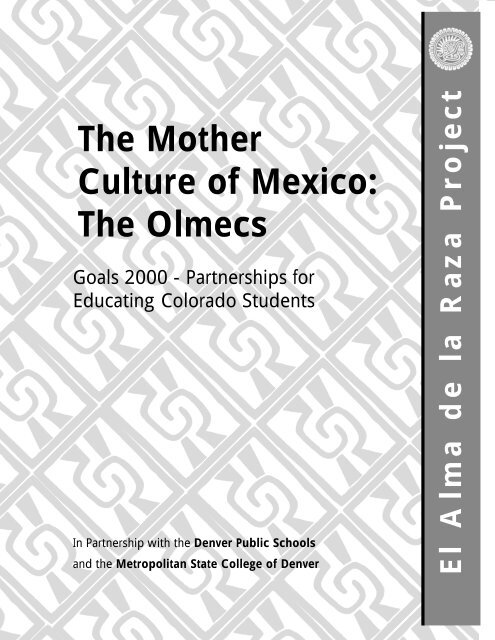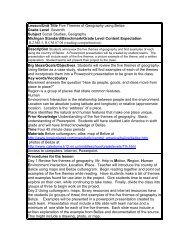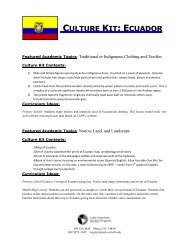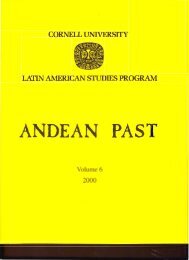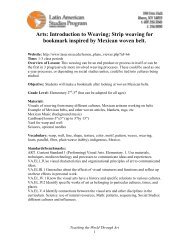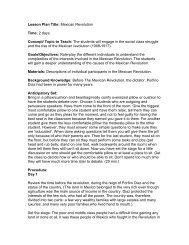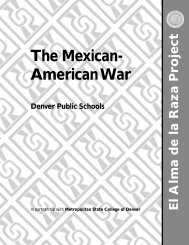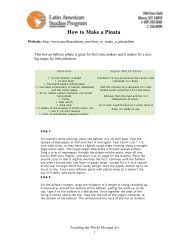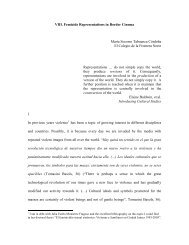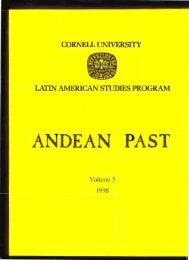The Mother Culture of Mexico: The Olmecs - Outreach World
The Mother Culture of Mexico: The Olmecs - Outreach World
The Mother Culture of Mexico: The Olmecs - Outreach World
You also want an ePaper? Increase the reach of your titles
YUMPU automatically turns print PDFs into web optimized ePapers that Google loves.
<strong>The</strong> <strong>Mother</strong><br />
<strong>Culture</strong> <strong>of</strong> <strong>Mexico</strong>:<br />
<strong>The</strong> <strong>Olmecs</strong><br />
Goals 2000 - Partnerships for<br />
Educating Colorado Students<br />
In Partnership with the Denver Public Schools<br />
and the Metropolitan State College <strong>of</strong> Denver<br />
El Alma de la Raza Project
<strong>The</strong> <strong>Mother</strong> <strong>Culture</strong> <strong>of</strong> <strong>Mexico</strong>:<br />
<strong>The</strong> <strong>Olmecs</strong><br />
By Daniel Villescas<br />
Grade 6<br />
Implementation Time<br />
for Unit <strong>of</strong> Study: 3-5 weeks<br />
Goals 2000 - Partnerships for<br />
Educating Colorado Students<br />
El Alma de la Raza Curriculum<br />
and Teacher Training Project<br />
Loyola A. Martinez, Project Director<br />
El Alma de la Raza Series
<strong>The</strong> <strong>Mother</strong> <strong>Culture</strong> <strong>of</strong> <strong>Mexico</strong>: <strong>The</strong> <strong>Olmecs</strong><br />
• Geography <strong>of</strong> <strong>Mexico</strong><br />
• History <strong>of</strong> the <strong>Olmecs</strong><br />
• Artistry <strong>of</strong> the <strong>Olmecs</strong><br />
Unit Concepts<br />
Standards Addressed by This Unit<br />
History<br />
Students understand the chronological organization <strong>of</strong> history and know how to organize<br />
events and people into major eras to identify and explain historical relationships.<br />
(H1)<br />
Students know how to use the processes and resources <strong>of</strong> historical inquiry. (H2)<br />
Students know that religious and philosophical ideas have been powerful forces<br />
throughout history. (H6)<br />
Students use appropriate technologies to obtain historical information; to study and/or<br />
model historical information and concepts; and to access, process and communicate<br />
information related to the study <strong>of</strong> history. (H7)<br />
Geography<br />
Students know how to use and construct maps and other geographic tools to locate and<br />
derive information about people, places, and environments. (G1)<br />
Students know the physical and human characteristics <strong>of</strong> places and use this knowledge<br />
to define and study regions and their patterns <strong>of</strong> change. (G2)<br />
Reading and Writing<br />
Students read to locate, select, and make use <strong>of</strong> relevant information from a variety <strong>of</strong><br />
media, reference, and technological sources. (RW5)<br />
Students use appropriate technologies to extend comprehension and communication<br />
skills in reading, writing, speaking, listening, and viewing. (RW7)<br />
Visual Arts<br />
Students recognize and use the visual arts as a form <strong>of</strong> communication. (A1)<br />
Students know and apply elements <strong>of</strong> art, principles <strong>of</strong> design, and sensory and expressive<br />
features <strong>of</strong> visual arts. (A2)<br />
Students know and apply visual arts materials, tools, techniques, ad nprocesses. (A3)<br />
Students relate the visual arts to various historical and cultural traditions. (A4)<br />
Goals 2000 Partnership for Educating Colorado Students 1
Introduction<br />
For many hundreds <strong>of</strong> years the Mayan, Zapotec and Toltecs were considered by many to be the<br />
first Indians <strong>of</strong> <strong>Mexico</strong>. However, within the last 100 years, a newly discovered culture has come<br />
to the forefront <strong>of</strong> scientific and historical inquiry. This is Olmec civilization. <strong>The</strong> origins <strong>of</strong> this<br />
civilization are located in the states <strong>of</strong> Veracruz, Tabasco, and Oaxaca, between the Grijalva and<br />
Papaloapa rivers in southern <strong>Mexico</strong>.<br />
<strong>The</strong> <strong>Olmecs</strong> began around the year <strong>of</strong> 1300 B.C. and began to die out around 200 B.C. <strong>The</strong>y established<br />
grand cities with centers <strong>of</strong> worship, marketplaces temples and developed trade routes;<br />
they were able to navigate the waterways <strong>of</strong> <strong>Mexico</strong> to move large stone heads to various<br />
regions <strong>of</strong> the Olmec kingdom. <strong>The</strong> cities that flourished during the Olmec era were: La Venta,<br />
San Lorenza, Laguna de los Cerros, and Tres Zapotes. <strong>The</strong>se cities were supported by a fully<br />
developed agricultural system, based on corn (maize), beans (frijoles) and squash (calabaza).<br />
Art and culture also flourished under the <strong>Olmecs</strong>; artwork is still being uncovered today with<br />
the distinct artistic form developed by the <strong>Olmecs</strong>. Also still being unearthed are the colossal or<br />
giant stone heads that exemplify or symbolize the Olmec Indians.<br />
Implementation Guidelines<br />
This unit coincides with the sixth grade social studies curriculum. It should be introduced prior<br />
to the introduction <strong>of</strong> the Aztec, Maya, and Inca Indian tribes. While the unit can be used to<br />
compare/contrast Indian tribes, it should be emphasized that much <strong>of</strong> the artistry, traditions,<br />
and customs <strong>of</strong> the Aztecs and Maya were inherited from the <strong>Olmecs</strong>. <strong>The</strong> teacher should use<br />
his/her discretion in implementating the art projects. Although they can be time-consuming<br />
and messy, they are very important to an understanding <strong>of</strong> Olmec artistry.<br />
Instructional Materials and Resources<br />
Atlases<br />
Maps <strong>of</strong> <strong>Mexico</strong><br />
Library and Internet access<br />
Art supplies (clay, materials for papier mâché)<br />
Lesson Summary<br />
Lesson 1<br />
Lesson 2<br />
Lesson 3<br />
Lesson 4<br />
Geography <strong>of</strong> <strong>Mexico</strong><br />
Developing a political map <strong>of</strong> <strong>Mexico</strong> and a map <strong>of</strong> the specific area <strong>of</strong> Olmec<br />
civilization.<br />
Olmec Civilization<br />
Researching Olmec art, religion, and architecture.<br />
Olmec Timetable<br />
Researching important Olmec dates and events and comparing them to<br />
significant dates and events in other civilizations in the same time period.<br />
Olmec Artistry<br />
Constructing Olmec giant heads, altars, and sculptures.<br />
Goals 2000 Partnership for Educating Colorado Students 2
What will students be learning?<br />
Lesson 1: Geography <strong>of</strong> <strong>Mexico</strong><br />
STANDARD(S)<br />
Students know how to use and construct maps and other geographic tools to locate and derive<br />
information about people, places, and environments. (G1)<br />
Students know the physical and human characteristics <strong>of</strong> places and use this knowledge to<br />
define and study regions and their patterns <strong>of</strong> change.(G2)<br />
BENCHMARK(S)<br />
Students know how to use maps and other geographic tools to acquire, process, and report<br />
information from a spatial perspective.<br />
OBJECTIVE(S)<br />
Students will complete a political map <strong>of</strong> <strong>Mexico</strong>, naming the states, capitals, and various<br />
bodies <strong>of</strong> water near or within <strong>Mexico</strong>. Students will create a map <strong>of</strong> the specific area <strong>of</strong> the<br />
Olmec civilization.<br />
SPECIFICS<br />
<strong>The</strong> beginnings <strong>of</strong> Olmec culture were established in southeastern <strong>Mexico</strong>, in the states <strong>of</strong><br />
Veracruz and Tabasco, between the Grijalva and Papaloapa Rivers. <strong>The</strong>re were over 45 different<br />
Olmec cities throughout southeastern <strong>Mexico</strong>, Guatemala, and Belize. However, there were<br />
three main capitals <strong>of</strong> the civilization—La Venta, San Lorenzo, and Tres Zapotes. Each <strong>of</strong> these<br />
cities was established strategically so its occupants could take advantage <strong>of</strong> the natural resources<br />
surrounding it.<br />
Prior to the <strong>Olmecs</strong>, the Indians <strong>of</strong> <strong>Mexico</strong> were hunters and gatherers. <strong>The</strong>y were nomadic,<br />
spending very little time in one location. As soon as the animals they hunted became scarce in<br />
one area, they gathered the few belongings they had and moved to a new location with the hope<br />
<strong>of</strong> more plentiful game. When the <strong>Olmecs</strong> settled in southeastern <strong>Mexico</strong> (Veracruz, Tabasco,<br />
Oaxaca), they established agricultural staples such as corn, squash, and beans. <strong>The</strong>y also constructed<br />
large cities, religious centers, and trade routes. <strong>The</strong>y developed a distinct culture,<br />
characterized by highly developed art and religion.<br />
What will be done to help students learn this?<br />
INSTRUCTIONAL STRATEGIES<br />
Visual examples<br />
Direct interaction<br />
ACTIVITIES<br />
<strong>The</strong> teacher presents an introduction to Olmec civilization, describing the importance <strong>of</strong> the<br />
<strong>Olmecs</strong> to the history <strong>of</strong> <strong>Mexico</strong>. A class map <strong>of</strong> <strong>Mexico</strong> is used as an introduction to <strong>Mexico</strong> and<br />
the location <strong>of</strong> Olmec civilization. After receiving a map packet containing a political map <strong>of</strong><br />
<strong>Mexico</strong> and an enlargement <strong>of</strong> the southeast area <strong>of</strong> <strong>Mexico</strong>, use classroom atlases and maps to<br />
label the maps in the packet. <strong>The</strong> cities, states, regions, bodies <strong>of</strong> water, and other geographic<br />
Goals 2000 Partnership for Educating Colorado Students 3
Lesson 1 (cont.)<br />
areas and terms that need to be included can be found on the guidesheets: Labeling a Political<br />
Map <strong>of</strong> <strong>Mexico</strong> and Labeling a Map <strong>of</strong> Southeastern <strong>Mexico</strong>. Complete definitions for a list <strong>of</strong><br />
geographic terms found on the Geographical Terms worksheet.<br />
VOCABULARY<br />
<strong>The</strong> following words should be used as vocabulary in this unit. However, the teacher can use<br />
his/her discretion in adding or subtracting words.<br />
bay<br />
canyon<br />
coast<br />
desert<br />
forest<br />
gulf<br />
harbor<br />
hill<br />
island<br />
isthmus<br />
lake<br />
mountain<br />
mountain range<br />
ocean<br />
peninsula<br />
plains<br />
plateau<br />
river<br />
sea<br />
valley<br />
Body <strong>of</strong> water partially enclosed by land but with a wide mouth, affording<br />
access to the sea<br />
Deep, narrow valley with high, steep slopes<br />
Land along a large lake, sea, or ocean<br />
Large land area that receives very little rainfall<br />
Large land area covered with trees<br />
Large area <strong>of</strong> water that lies within a curved coastline<br />
Sheltered body <strong>of</strong> water where ships can anchor safely<br />
Small area <strong>of</strong> land, higher than the land around it<br />
Piece <strong>of</strong> land surrounded by water<br />
Narrow piece <strong>of</strong> land that joins two larger sections <strong>of</strong> land<br />
Inland body <strong>of</strong> water<br />
Land that rises much higher than the land around it<br />
Row <strong>of</strong> mountains that are joined together<br />
Any <strong>of</strong> the large bodies <strong>of</strong> water into which the whole body <strong>of</strong> salt water<br />
that covers much <strong>of</strong> the Earth is divided<br />
Piece <strong>of</strong> land that projects into a body <strong>of</strong> water and is connected with the<br />
mainland by an isthmus<br />
Extensive area <strong>of</strong> level or rolling treeless country<br />
Large, high land area that is generally flat<br />
Large body <strong>of</strong> fresh water that moves from higher to lower land. Rivers<br />
usually flow into another river, sea, or ocean<br />
Large body <strong>of</strong> salt water nearly or partly surrounded by land. A sea is<br />
much smaller than an ocean<br />
Lower land between hills or mountains. A valley usually contains a river<br />
or a stream<br />
Goals 2000 Partnership for Educating Colorado Students 4
Lesson 1 (cont.)<br />
RESOURCES/MATERIALS<br />
colored pencils<br />
classroom atlases<br />
<strong>Mexico</strong> roller map<br />
Labeling a Political Map <strong>of</strong> <strong>Mexico</strong><br />
Labeling a Map <strong>of</strong> Southeastern <strong>Mexico</strong><br />
Geographical Terms<br />
map <strong>of</strong> <strong>Mexico</strong>, such as from the Rand/McNally Cosmopolitan Series<br />
reproduced copies <strong>of</strong> political map <strong>of</strong> <strong>Mexico</strong><br />
reproduced copies <strong>of</strong> enlarged area <strong>of</strong> Olmec civilization<br />
magnifying lens strips or magnifying glass<br />
ASSESSMENT<br />
Visual check <strong>of</strong> the maps, which includes checking location <strong>of</strong> states and capitals as well as<br />
proper use <strong>of</strong> geographic terms.<br />
Goals 2000 Partnership for Educating Colorado Students 5
Labeling a Political Map <strong>of</strong> <strong>Mexico</strong><br />
Include these bodies <strong>of</strong> water, geographic regions, states, and capitals on your political<br />
map <strong>of</strong> <strong>Mexico</strong>.<br />
Bodies <strong>of</strong> Water<br />
Gulf <strong>of</strong> California<br />
Gulf <strong>of</strong> <strong>Mexico</strong><br />
Pacific Ocean<br />
Gulf <strong>of</strong> Tehuantepec<br />
Gulf <strong>of</strong> Campeche<br />
Caribbean Sea<br />
Geographic Regions<br />
Sierra Madre Oriental Mountains<br />
Sierra Madre Occidental Mountains<br />
Isthmus <strong>of</strong> Tehuantepec<br />
Tuxtla Mountains (in southeast Veracruz; may not be found on map, place at approximately<br />
20° N latitude and 95° W longitude)<br />
States<br />
Chihuahua<br />
Sonora<br />
Coahuila<br />
Durango<br />
Oaxaca<br />
Jalisco<br />
Tamaulipas<br />
Zacatecas<br />
Chiapas<br />
Baja California South<br />
Veracruz<br />
Baja California North<br />
Nuevo León<br />
Guerrero<br />
San Luis Potosí<br />
Michoacán<br />
Sinaloa<br />
Campeche<br />
Quintana Roo<br />
Yucatán<br />
Capitals<br />
Chihuahua<br />
Hermosillo<br />
Saltillo<br />
Durango<br />
Oaxaca<br />
Guadalajara<br />
Ciudad Victoria<br />
Zacatecas<br />
Tuxtla Gutiérrez<br />
La Paz<br />
Jalapa<br />
Mexicali<br />
Monterrey<br />
Chilpancingo<br />
San Luis Potosí<br />
Morelia<br />
Culiacán<br />
Campeche<br />
Chetumal<br />
Mérida<br />
Goals 2000 Partnership for Educating Colorado Students 6
Labeling a Political Map <strong>of</strong> <strong>Mexico</strong> (cont.)<br />
States<br />
Puebla<br />
Guanajuato<br />
Nayarit<br />
Tabasco<br />
México<br />
Hidalgo<br />
Querétaro<br />
Aguascalientes<br />
Colima<br />
Morelos<br />
Tlaxcala<br />
Distrito Federal<br />
Capitals<br />
Puebla<br />
Guanajuato<br />
Tepic<br />
Villahermosa<br />
Toluca<br />
Pachuca<br />
Querétaro<br />
Aguascalientes<br />
Colima<br />
Cuernavaca<br />
Tlaxcala<br />
Ciudad México<br />
Goals 2000 Partnership for Educating Colorado Students 7
Labeling a Map <strong>of</strong> Southeastern <strong>Mexico</strong><br />
Include these bodies <strong>of</strong> water, geographic regions, states, capitals, and cities on your<br />
map <strong>of</strong> Southeastern <strong>Mexico</strong>.<br />
Bodies <strong>of</strong> Water<br />
Gulf <strong>of</strong> Tehuantepec<br />
Gulf <strong>of</strong> Campeche<br />
Grijalva River<br />
Papaloapa River<br />
Geographic Regions<br />
Isthmus <strong>of</strong> Tehuantepec<br />
Tuxtla Mountains (in southeast Veracruz; may not be found on map, place at approximately<br />
20° N latitude and 95° W longitude)<br />
States<br />
Veracruz<br />
Oaxaca<br />
Chiapas<br />
Tabasco<br />
Guerrero<br />
Capitals<br />
Jalapa<br />
Oaxaca<br />
Tuxtla Gutiérrez<br />
Villahermosa<br />
Chilpancingo<br />
Cities<br />
Monte Alban<br />
La Venta<br />
Tres Zapotes<br />
Goals 2000 Partnership for Educating Colorado Students 8
Geographical Terms<br />
Word<br />
Definition<br />
bay<br />
canyon<br />
coast<br />
desert<br />
forest<br />
gulf<br />
harbor<br />
hill<br />
island<br />
isthmus<br />
lake<br />
Goals 2000 Partnership for Educating Colorado Students 9
Geographical Terms (cont.)<br />
Word<br />
Definition<br />
mountain<br />
mountain range<br />
ocean<br />
peninsula<br />
plains<br />
plateau<br />
river<br />
sea<br />
valley<br />
Goals 2000 Partnership for Educating Colorado Students 10
What will the students be learning?<br />
Lesson 2: Olmec Civilization<br />
STANDARDS(S)<br />
Students know how to use the processes and resources <strong>of</strong> historical inquiry. (H2)<br />
Students know that religious and philosophical ideas have been powerful forces throughout<br />
history. (H6)<br />
Students use appropriate technologies to obtain historical information; to study and/or model<br />
historical information and concepts; and to access, process, and communicate information<br />
related to the study <strong>of</strong> history. (H7)<br />
BENCHMARK(S)<br />
Students know how to interpret and evaluate primary and secondary sources <strong>of</strong> historical<br />
information.<br />
Students know how various forms <strong>of</strong> expression reflect religious beliefs and philosophical ideas.<br />
Students use appropriate technologies to enable historical inquiry.<br />
OBJECTIVE(S)<br />
Students will independently research information on the <strong>Olmecs</strong> using books, articles, encyclopedias,<br />
and the Internet.<br />
What will be done to help students learn this?<br />
INSTRUCTIONAL STRATEGIES<br />
Classroom lecture<br />
Library and Internet access<br />
ACTIVITIES<br />
Read the Olmec Historical Summary. <strong>The</strong>n research Olmec art, religion, or architecture and<br />
organize the information and pictures into a report.<br />
VOCABULARY<br />
civilization<br />
An advanced state <strong>of</strong> intellectual, cultural, and material development in<br />
human society, marked by progress in the arts and sciences, the extensive<br />
use <strong>of</strong> writing, and the appearance <strong>of</strong> complex political and social<br />
institutions.<br />
RESOURCES/MATERIALS<br />
books and encyclopedias<br />
magazines (especially National Geographic)<br />
CD-ROMs<br />
Internet access<br />
ASSESSMENT<br />
Assess report for accuracy, quality <strong>of</strong> research, and writing.<br />
Goals 2000 Partnership for Educating Colorado Students 11
Olmec Historical Summary<br />
It wasn’t until this century that the <strong>Olmecs</strong> were acknowledged to be part <strong>of</strong> <strong>Mexico</strong>’s<br />
history. Researchers prior to this time attributed many <strong>of</strong> the discoveries now associated<br />
with the <strong>Olmecs</strong> to Mayan, Toltec, or even Chichimecan cultures. However, due to<br />
advances in scientific dating, scientists were able to determine that the art, artifacts, and<br />
miscellaneous objects found at La Venta, Tres Zapotes, and San Lorenzo were from a<br />
period <strong>of</strong> time earlier than the Maya.<br />
<strong>The</strong> <strong>Olmecs</strong>, which means “people <strong>of</strong> rubber” in Nahuatl (the ancient language <strong>of</strong> the<br />
Aztecs), began their civilization in southeastern <strong>Mexico</strong> between 1600 B.C. and 1400 B.C..<br />
It is believed that the <strong>Olmecs</strong> created their first cities between the Grijalva and Papaloan<br />
rivers, in the present-day Mexican states <strong>of</strong> Oaxaca, Veracruz, Chiapas, and Tabasco.<br />
<strong>The</strong> <strong>Olmecs</strong> had approximately 45 different cities. However, there were three main<br />
cities. Some researchers claim that each city was a capital that controlled trade routes,<br />
provided defense from attacking tribes, and was responsible for the accumulation <strong>of</strong><br />
natural resources in the area. <strong>The</strong> three cities were Tres Zapotes, La Venta, and Monte<br />
Alban. <strong>The</strong>se cities were east <strong>of</strong> the Tuxtla Mountains and the Southern Mountain<br />
Range (Sierra Madre del Sur). <strong>The</strong> locations <strong>of</strong> these cities on a map show a triangle <strong>of</strong><br />
control and power.<br />
<strong>The</strong> geograpical area <strong>of</strong> the Olmec civilization is varied in its features. It is close to the<br />
Gulf <strong>of</strong> <strong>Mexico</strong> and the Pacific Ocean on the Isthmus <strong>of</strong> Tehuantepec. It was a humid<br />
area and contained a varied landscape <strong>of</strong> jungles, plains, and mountains.<br />
<strong>The</strong> <strong>Olmecs</strong> established cities, trade routes over land and water, and most importantly,<br />
an agricultural system that could feed those who lived in those cities. Corn<br />
(maize), beans (frijoles), and squash (calabaza) were planted and harvested. <strong>The</strong>se<br />
crops are still prevalent in <strong>Mexico</strong>. <strong>The</strong> <strong>Olmecs</strong> were also known to have domesticated<br />
dogs and turkeys. <strong>The</strong>re is some evidence that they practiced cannibalism as well;<br />
however, this has not been completely proven. <strong>The</strong> <strong>Olmecs</strong> lived in a society based on<br />
a theocratic form <strong>of</strong> government (government ruled by or subject to religious authority).<br />
Religion played a major role in the lives <strong>of</strong> the <strong>Olmecs</strong>. Scientists and historians<br />
have unearthed altars and other sculptures that support this.<br />
<strong>The</strong> giant heads <strong>of</strong> the <strong>Olmecs</strong> are quite unusual. <strong>The</strong> first head was discovered in 1862<br />
in southern Veracruz by Jose Maria Melgar. It wasn’t until 1925 that a second giant head<br />
was discovered, along with several other objects. In 1929, Marshall H. Saville, coined<br />
the phrase the “Olmec” in a paper that he published.<br />
In much Olmec art and other objects, there are two repeating themes: the use <strong>of</strong> jade<br />
and the symbol <strong>of</strong> the jaguar. Both <strong>of</strong> these held special meaning for the <strong>Olmecs</strong>. <strong>The</strong><br />
<strong>Olmecs</strong> and other Indians <strong>of</strong> <strong>Mexico</strong> believed that the jaguar had special powers.<br />
<strong>The</strong> <strong>Olmecs</strong> used stone from as far as 60 miles away to sculpt their giant heads. It is now<br />
believed that these heads were meant to honor famous leaders and/or warriors. To date<br />
16 heads have been found, the tallest standing over eleven feet.<br />
Goals 2000 Partnership for Educating Colorado Students 12
What will students be learning?<br />
Lesson 3: Olmec Timeline<br />
STANDARD(S)<br />
Students understand the chronological organization <strong>of</strong> history and know how to organize<br />
events and people into major eras to identify and explain historical relationships. (H1)<br />
Students know how to use the processes and resources <strong>of</strong> historical inquiry. (H2)<br />
BENCHMARK(S)<br />
Students use chronology to organize historical events and people.<br />
Students know how to interpret and evaluate primary and secondary sources <strong>of</strong> historical<br />
information.<br />
OBJECTIVE(S)<br />
Students will create a timeline <strong>of</strong> Olmec civilization relating Olmec dates and events to dates<br />
and events in other civilizations.<br />
What will be done to help students learn this?<br />
INSTRUCTIONAL STRATEGIES<br />
Independent research<br />
Timeline<br />
ACTIVITIES<br />
In groups <strong>of</strong> 2–3, research Olmec events and dates. Include the beginning and ending dates for<br />
Olmec civilization and important events in betweeen these dates. Also include important dates/<br />
events in Rome or Mesopotamia in the same time period. A minimum <strong>of</strong> five dates and events<br />
should be included on the timeline.<br />
RESOURCES/MATERIALS<br />
access to library or Internet<br />
ASSESSMENT<br />
Accuracy <strong>of</strong> sequence and number <strong>of</strong> dated events on timeline.<br />
Goals 2000 Partnership for Educating Colorado Students 13
What will students be learning?<br />
Lesson 4: Olmec Artistry<br />
STANDARD(S)<br />
Students recognize and use the visual arts as a form <strong>of</strong> communication. (A1)<br />
Students know and apply elements <strong>of</strong> art, principles <strong>of</strong> design, and sensory and expressive<br />
features <strong>of</strong> visual arts. (A2)<br />
Students know and apply visual arts materials, tools, techniques, and processes. (A3)<br />
Students relate the visual arts to various historical and cultural traditions. (A4)<br />
OBJECTIVE(S)<br />
Using modeling clay or papier-mâché, students will construct replicas <strong>of</strong> Olmec artwork.<br />
SPECIFIC(S)<br />
Olmec civilization had a very complex division <strong>of</strong> labor; their population included artisans,<br />
craftspeople, priests, and a variety <strong>of</strong> other workers. It has become apparent in the last fifty<br />
years that the <strong>Olmecs</strong> made incredible achievements in art, architecture, and religion. Artistically,<br />
the <strong>Olmecs</strong> are known for their large stone carved heads, sculptures made <strong>of</strong> jade, and<br />
masks. Architecturally the <strong>Olmecs</strong> were great planners. Even today (in the ancient city <strong>of</strong> La<br />
Venta) a pyramid stands that is over 500 feet in diameter and 100 feet tall. <strong>The</strong> <strong>Olmecs</strong>’ polytheistic<br />
religious beliefs are revealed in altars for worship and stone glyphs that tell their history.<br />
(At the time <strong>of</strong> the <strong>Olmecs</strong>, symbols and drawings were used to write and express ideas.)<br />
What will be done to help students learn this?<br />
INSTRUCTIONAL STRATEGIES<br />
Demonstrations<br />
Visual aids<br />
PRELIMINARY LESSON PREPARATION<br />
Provide resources that have visual examples <strong>of</strong> the altars, sculptures, and giant heads <strong>of</strong> the<br />
<strong>Olmecs</strong> (books, encyclopedias, magazines, Internet access).<br />
ACTIVITIES<br />
After a class demonstration by the teacher, divide into groups <strong>of</strong> two or three. Using teacherprovided<br />
resources, groups will decide what they want to construct. Choose between a giant<br />
head, an altar, or a sculpture. Begin the process by drawing a rough draft <strong>of</strong> the final product. If<br />
there are symbols on the artwork, they should be explained.<br />
If using clay to make a giant head, mold the clay into a large ball or oblong object. Manipulate<br />
the clay to create facial features and/or a helmet. If using clay to construct an altar, manipulate<br />
the clay into a table framework. Design the altar, forming symbols and objects.<br />
If the class is using papier-mâché, the teacher should demonstrate. Inflate a balloon. Make sure<br />
that the balloon is not too large to work with. Using precut strips <strong>of</strong> newspaper (approximately<br />
one inch in width and six inches in length), dip the newspaper into a plastic bowl containing a<br />
pasty mixture <strong>of</strong> glue and water or flour, glue, and water. When pulling the newspaper out <strong>of</strong><br />
Goals 2000 Partnership for Educating Colorado Students 14
Lesson 4 (cont.)<br />
the mixture, run the newspaper strip through two fingers to remove the excess. <strong>The</strong>n apply the<br />
wet newspaper strip to the balloon and firmly press. This should be repeated until the entire<br />
balloon is covered. Allow approximately 24 hours to dry. Once the head is dry, paint can be<br />
applied on the newspaper to create the Olmec head. Encourage the students to be creative and<br />
not to copy their classmates. An important step in painting is to allow the students time to<br />
experiment with various colors and especially with mixing <strong>of</strong> colors.<br />
VOCABULARY<br />
altar<br />
sculpture<br />
art<br />
style<br />
expression<br />
image<br />
Elevated place or structure before which religions ceremonies may be<br />
enacted or upon which sacrifices may be <strong>of</strong>fered<br />
<strong>The</strong> art or practice <strong>of</strong> shaping figures or designs in the round or in relief,<br />
as by chiseling marble, modeling clay, or casting in metal. A work <strong>of</strong> art<br />
created by sculpture<br />
<strong>The</strong> conscious production or arrangement <strong>of</strong> sounds, colors, forms,<br />
movements, or other elements in a manner that affects the sense <strong>of</strong><br />
beauty, specifically the production <strong>of</strong> the beautiful in a graphic or plastic<br />
medium<br />
<strong>The</strong> combination <strong>of</strong> distinctive features <strong>of</strong> literary or artistic expresion,<br />
execution, or performance characterizing a particular person, group,<br />
school, or era<br />
<strong>The</strong> act <strong>of</strong> expressing, conveying, or representing in words, art, music, or<br />
movement; a manifestation<br />
A reproduction <strong>of</strong> the form <strong>of</strong> a person or object, especially a sculptured<br />
likeness<br />
RESOURCES/MATERIALS<br />
access to Internet<br />
books, magazines, and encyclopedias<br />
balloon<br />
water and water bucket<br />
newspaper<br />
flour<br />
glue<br />
tape<br />
paint<br />
scissors<br />
modeling clay<br />
synthetic models <strong>of</strong> Olmec art, such as Item #2153, Museo de Las Culturas Olmeca y Mixteco—<br />
Zapoteca, Figurines (Fernandez USA Publishing Co., (800) 814-8080).<br />
Optional resource: Los Olmecas: La Cultura Madre by Roman Piña Chan. This provides excellent<br />
visual examples for the students and teacher.<br />
ASSESSMENT<br />
Evaluate participation, effort and completion <strong>of</strong> project.<br />
Goals 2000 Partnership for Educating Colorado Students 15
Unit Assessment<br />
How will students demonstrate pr<strong>of</strong>iciency?<br />
PERFORMANCE TASK<br />
Use materials and information gathered during this unit to do a short oral presentation on the<br />
art, architecture, or religion <strong>of</strong> the <strong>Olmecs</strong>. Include maps, pictures, art objects, religious objects,<br />
timelines, or other materials as visual aids.<br />
SCORING RUBRIC<br />
4. Accurate and comprehensive. Excellent use <strong>of</strong> visual aids.<br />
3. Generally accurate and complete. Visual aids used fairly effectively.<br />
2. Fairly accurate, but incomplete information. Visual aids not used effectively.<br />
1. Inaccurate and incomplete information presented. Few, if any, visual aids.<br />
Goals 2000 Partnership for Educating Colorado Students 16
Bibliography<br />
Chan, Roman Piña. Los Olmecas: La Cultura Madre. Barcelona-Madrid: Lunwerg Editores, S.A.. 1990.<br />
Excellent source about all aspects <strong>of</strong> the <strong>Olmecs</strong>. Published in Spanish only.<br />
Davies, Nigel. <strong>The</strong> Ancient Kingdoms <strong>of</strong> <strong>Mexico</strong>: A Magnificent Re-creation <strong>of</strong> <strong>The</strong>ir Art and Life.<br />
London: Penguin Books, 1982.<br />
Provides a good overview <strong>of</strong> the <strong>Olmecs</strong>, especially about their history, location, and<br />
traditions.<br />
King, Jaime Litvak. Ancient <strong>Mexico</strong>: An Overview. Albuquerque: University <strong>of</strong> New <strong>Mexico</strong> Press,<br />
1985.<br />
Does a good job <strong>of</strong> introducing the <strong>Olmecs</strong>; however, does not provide enough depth.<br />
Loprete, Carlos A. and McMahon. IberoAmerica: Sintesis de su civilization. New York: Charles<br />
Scribner’s Sons, 1965.<br />
Does not discuss the <strong>Olmecs</strong>; however, has a nice map placing them in the correct region<br />
<strong>of</strong> <strong>Mexico</strong>.<br />
Parks, Henry Bamford. A History <strong>of</strong> <strong>Mexico</strong>. New York: Houghton Mifflin Company, 1960.<br />
Discusses the <strong>Olmecs</strong>; however, does not give full acknowledgment <strong>of</strong> their existence or<br />
contributions.<br />
Smith, Bradely. <strong>Mexico</strong>: A History in Art. <strong>Mexico</strong>: Gemini Smith Inc., 1968.<br />
Very good source that provides illustrations <strong>of</strong> Olmec art. Great visuals.<br />
Internet<br />
http://udgftp.cencar.udg.mx/ingles/precolombina/olmecas/docs/olmin.html<br />
Very good resource. Provides a brief, detailed history. Very good illustrations <strong>of</strong> sculptures.<br />
Includes information on the art, scuptures, themes, and forms <strong>of</strong> Olmec artistry.<br />
http://www.tam.itesm.mx/~jdorante/art/olmeca/iolmec04.htm<br />
This web page does not go into great depth regarding the <strong>Olmecs</strong>. However, it does<br />
provide a picture <strong>of</strong> an Olmec ax or hacha.<br />
http://www.cultures.com/contests/heads/em_all.html<br />
Excellent resource page with useful links. Illustrations <strong>of</strong> Olmec heads can be accessed<br />
from this site.<br />
http://www.cultures.com/contests/heads/olmecs–contest–e.html<br />
Extension <strong>of</strong> web page listed above. Good research page that provides important dates<br />
when discoveries were made by Western historians.<br />
http://homepages.luc.edu/~cwinter/priest2.htm<br />
Very difficult web page for sixth graders to interpret. However, the depth <strong>of</strong> discussion<br />
and facts are helpful to the teacher. <strong>The</strong> additional links are equally difficult. Provides<br />
the teacher with good resource bibliography for additional research. Not recommended<br />
for class research.<br />
http://www.crystalinks.com/olmec.html<br />
Good web page that provides a detailed summary <strong>of</strong> what is know about the <strong>Olmecs</strong>, as<br />
well as what has been accomplished by historians, archaeologists, and researchers since<br />
the discovery <strong>of</strong> the <strong>Olmecs</strong> in the 19th and 20th centuries. Also very good visuals.<br />
Goals 2000 Partnership for Educating Colorado Students 17
About the Author<br />
Daniel Villescas was born in El Paso, Texas and moved to Denver in the late 1970s. He attended<br />
Metropolitan State College <strong>of</strong> Denver and graduated with a degree in history. He is currently<br />
pursuing a masters degree from Regis University in education.<br />
Daniel has worked in Denver Public Schools for two years. Currently, he is at Lake Middle<br />
School, where he teaches sixth grade bilingual social studies and English as a Second Language.<br />
At Lake, Daniel serves on the ISA advisory team and is also the schools flag football coach.<br />
Daniel is married and the proud father <strong>of</strong> his son, Alexander Xavier Villescas, who will turn one<br />
at the end <strong>of</strong> July. He is the third <strong>of</strong> four brothers and is the only one to choose a career in education.<br />
He believes that “we have the power and responsibility to educate the youth <strong>of</strong> today.”<br />
Goals 2000 Partnership for Educating Colorado Students 18


